RBSE Solutions for Class 8 Maths Chapter 5 Data Handling Intext Questions
Rajasthan Board RBSE Solutions for Class 8 Maths Chapter 5 Data Handling Intext Questions Textbook Exercise Questions and Answers.
RBSE Class 8 Maths Solutions Chapter 5 Data Handling Roots Intext Questions
(Page No: 69)
Think Discuss And Write Class 8 Data Handling Question 1.
A Pictograph : Pictorial representation data using symbols.
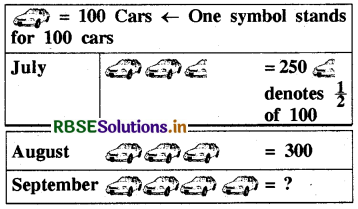
(i) How many cars were produced in the month of July?
(ii) In which month were maximum number of cars produced?
Answer:
(i) 250 cars
(ii) September

Class 8 Maths Chapter 5 Think Discuss And Write Question 2.
A bar graph
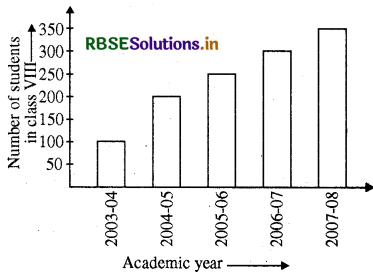
(i) What is the information given by the bar graph?
(ii) In which year is the increase in the number of students maximum?
(iii) In which year is the number of students maximum?
(iv) State whether true or false :
‘The number of students during 2005-06 is twice that of 2003-04.’
Answer:
(i) The information given by the bar graph is the number of students in class VIII in various academic years in the school.
(ii) In the year 2004-05.
(iii) In the year 2007-08.
(iv) False.
Class 8 Data Handling Think Discuss And Write Question 3.
Ddouble Bar Graph
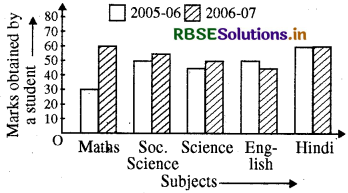
(i) What is the information given by the double bar graph?
(ii) In which subject has the performance improved the most?
(iii) In which subject has the performance deteriorated?
(iv) In which subject is the performance at par?
Answer:
(i) The graph gives the information about the comparison of marks in different subjects obtained by a student in the year 2005-06 and 2006-07.
(ii) In Mathematics.
(iii) In English.
(iv) In Hindi.

(Think, Discuss and Write Page No: 71)
Class 8 Maths Chapter 5 Think Discuss And Write Solutions Question 1.
If we change the position of any of the bars of a bar graph, would it change the information being conveyed? Why?
Answer:
If we change the position of any of the bars of a bar graph, it would not change the information being conveyed.
(Try These Page No: 71)
Draw an appropriate graph to represent the given information.
Class 8 Maths Data Handling Try These Solutions Question 1.
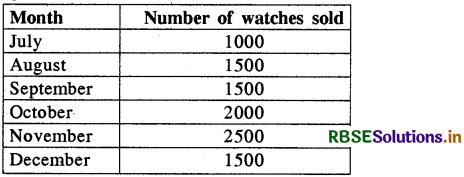
Answer:
To represent the given data by a bar graph, we represent ‘month’ on X axis and ‘number of watches sold’ on Y axis. Since six values of numerical data are given, so we mark six points on the horizontal line at equal distances and rectangles of the same width at these points. The heights of the rectangle are proportional to the numerical values of the data as shown in the figure.
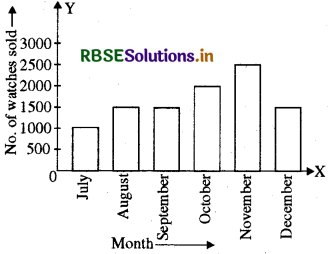
Class 8 Data Handling Try These Question 2.

Answer:
To represent the gives data by a bar graph, we represent ‘preference of children’ on the X-axis and ‘no. of children’ on the Y- axis. Two values of the numerical data for schools A, B and C are given, so we mark two points on the horizontal line at equaWdi stances and draw rectangles at each point of the same width at there points. The height of the rectangles are proportional to the numerical values of the data as shown in the figure.
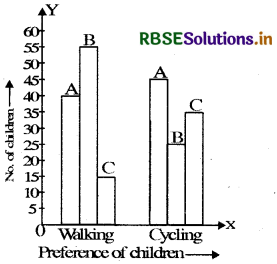

Try These Solutions Class 8 Data Handling Question 3.
Percentage wins in ODI by 8 top cricket teams.
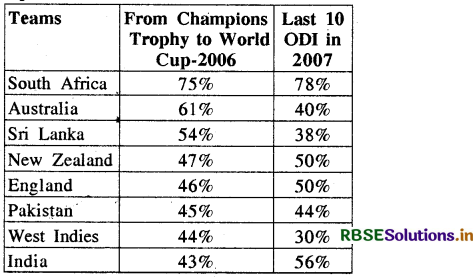
Answer:
We represent the ‘team’ along OX and ‘percentage wins’ on OY. Champions Trophy to World Cup 2006 is shown by dotted line and ODI in 2007 is shown by the thick line.
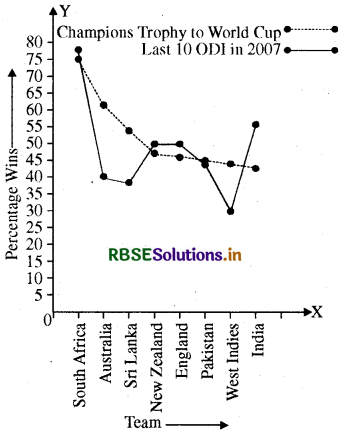

(Try These Page No: 72)
Class 8 Maths Chapter 5 Try These Solutions Question 1.
A group of students were asked to say which animal they would like most to have as a pet. The results are given below:
dog, cat, cat, fish, cat, rabbit, dog, cat, rabbit, dog, cat, dog, dog, dog, cat, cow, fish, rabbit, dog, cat, dog, cat, cat, dog, rabbit, cat, fish, dog.
Make a frequency distribution table for the same.
Answer:
We arrange the data in a frequency table using tally marks as below:
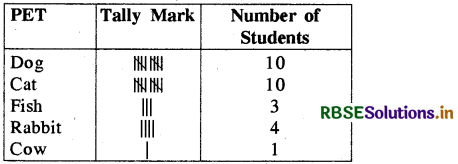
(Try These Page No: 73)
Data Handling Class 8 Try These Question 1.
Study the following frequency distribution table and answer the questions given below.

(i) What is the size of the class intervals?
(ii) Which class has the highest frequency?
(iii) Which class has the lowest frequency?
(iv) What is .the upper limit of the class interval 250-275?
(v) Which two classes have the same frequency?
Answer:
(i) 25
(ii) 220-225
(iii) 300-325
(iv) 275
(v) 150-175 and 225-250

Data Handling Class 8 Try These Solutions Question 2.
Construct a frequency distribution table for the data on weights (in kg) of 20 students of a class using intervals 30-35, 35-40 and so on.
40, 38, 33, 48, 60, 53, 31, 46, 34, 36, 49, 41, 55, 49, 65, 42, 44, 47, 38, 39.
Answer:
We make a grouped frequency table as below:
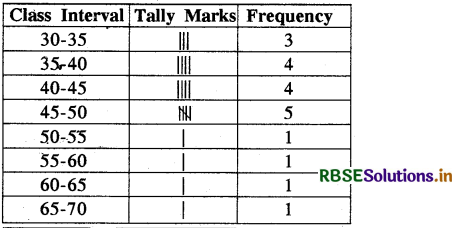
(Try These Page No: 75)
Try These Data Handling Class 8 Question 1.
Observe the histogram and answer the questions given below.

(i) What information is being given by the histogram?
(ii) Which group contains maximum girls?
(iii) How many girls have a height of 145 cms and more?
(iv) If we divide the girls into the following three categories, how many would there be in each?
150 cm and more - Group A
140 cm to less than 150 cm - Group B
Less than 140 cm - Group C
Answer:
(i) This histogram gives information about the height (m cm) of girls of class VII.
(ii) 140-145
(iii) 07
(iv) Group A contains 2 + 1, i.e. 3 girls
Group B contains 7 + 4, i.e. 11 girls
Group C contains 1 + 2 + 3, i.e. 6 girls

(Try These Page No: 78)
Class 8 Maths Ch 5 Try These Question 1.
Each of the following pie charts gives vou a different piece of information about your class. Find the fraction of the circle representing each of these information.
(i)
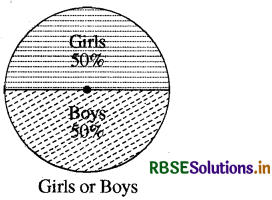
Answer:
From the given figure, it is clear
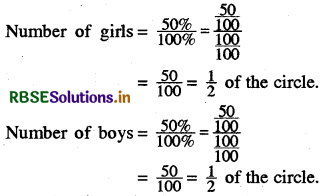
(ii)
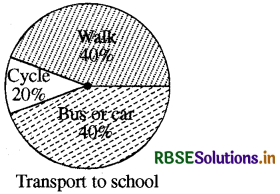
Answer:
From the given pie chart, it is clear
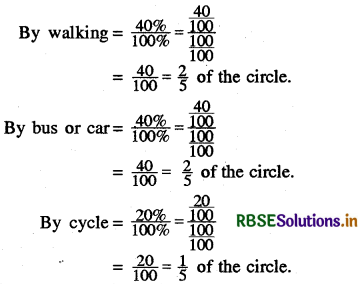
(iii)
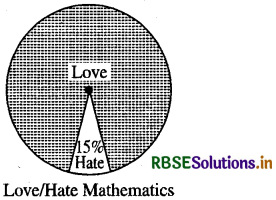
Answer:
It is clear from given pie chart,
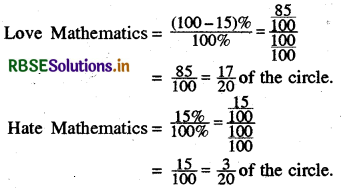

Class 8 Maths Ch 5 Think Discuss And Write Question 2.
Answer the following questions based on the pie chart given (Figure).
(i) Which type of programmes are viewed the most?
(ii) Which two types of programmes have number of viewers equal to those watching sports channels?
(ii) The programmes about news and information together have number of viewers equal to those watching sports channels.
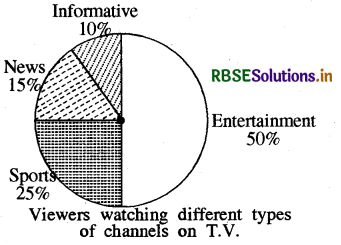
Answer:
From me given pie chart it is clear mat
(i) Entertainment programmes are viewed me most.
(ii) The programmes about news and information together have number of viewers equal to those watching sports channels.
(Try These Page No: 81)
Class 8 Maths Chapter 5 Think Discuss And Write Pg 81 Question 1.
Draw a pie chart of the data given below.
The time spent by a child during a day.
Sleep - 8 hours
School - 6 hours
Home work - 4 hours
Play - 4 hours
Others - 2 hours
Answer:
We represent this data in a pie chart. The total angle at me centre is 360°. The central angle of the sectors will be fraction of 360.
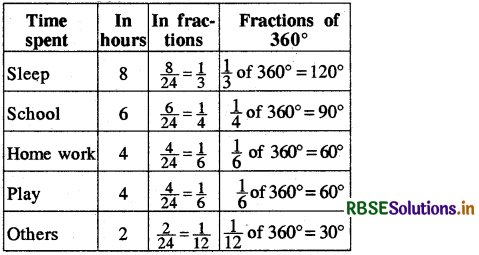
We make the pie chart as shown:
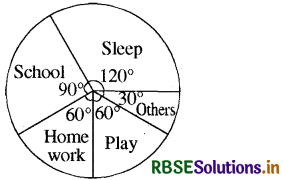

(Think, Discuss and Write Page No: 81)
Which form of graph would be appropriate to display the following data.
Think Discuss And Write Class 8 Pg 81 Question 1.
Production of food grains of a state.

Answer:
Bar graph is a appropriate graph to display the given datas.
Question 2.
Choice of food for a group of people.

Answer:
Bar graph is an appropriate graph to display the given datas.
Questions On Data Handling For Class 8 Question 3.
The daily income of a group of a factory workers.
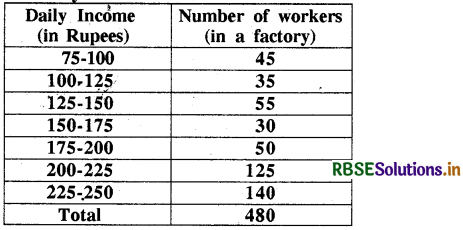
Answer:
Histogram is an appropiate graph to display the given datas.
(Try These Page No: 81)
Class 8 Maths Chapter 5 Try These (Page 81) Question 1.
If you try to start a scooter, what are the possible outcomes?
Answer:
In trying to start a scooter, the possible outcomes are that it may start or it may not start.
Think Discuss And Write Class 8 Chapter 5 Pg 81 Question 2.
When a die is thrown, what are the six possible outcomes?
Answer:
In throwing of a die, the possible outcomes are that any one of the six faces marked with 1, 2, 3, 4; 5, 6 may come uppermost.
Class 8 Maths Chapter 5 Try These Page 71 Question 3.
When you spin the wheel shown, what are the possible outcomes? List them.
(Outcome here means the sector at which the pointer stops).
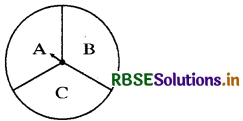
Answer:
In spinning a wheel, the possible outcomes means the sector of the wheel may stop at any of A, B or C.

Question 4.
You have a bag with five identical balls at different colours and you are to pull out (draw) a ball without looking at it; list the outcomes you would get. (See figure)
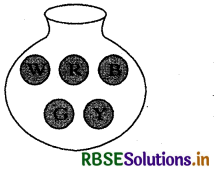
Answer:
In drawing one ball from a bag containing 1 white, 1 red, 1 blue, 1 green and 1 yellow balls, the possible outcomes are that any of W, R, B G or Y ball can be drawn out.
(Think, Discuss and Write Page No: 84)
Question 1.
In throwing a die:
- Does the first player have a greater chance of getting a six?
- Would the player who played after him have a lesser chance of getting a six?
- Suppose the second player got a six. Does it mean that the third player would not have a chance of getting a six?
Answer:
When a die is thrown several times, we note that each of the outcome i.e. 1, 2, 3, 4, 5 or 6 has the same chance of occurring. Therefore all have the equal chance of getting a six.
(Try These Page No: 86)
Question 1.
Suppose you spin the wheel
(i) List the number of outcomes of getting a green sector and not getting a green sector on this wheel (Fig).
(ii) Find the probability of getting a green sector.
(iii) Find the probability of not getting a green sector.
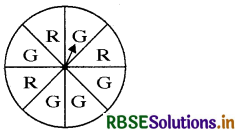
Answer:
(i) Number of outcomes of getting a green sector = 5
and the number of outcomes of not getting a green sector = 3
(ii) Probability of getting a green sector
= \(\frac{\text { Number of outcomes that make the event }}{\text { Total number of outcomes of the experiment }}\)
= \(\frac{5}{8}\)
(iii) Probability of not getting a greeen sector
= \(\frac{3}{8}\)
